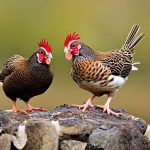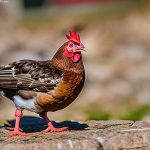Raising baby ducks and chickens together can be a rewarding experience for poultry enthusiasts. Both species are popular choices for backyard farming, and combining them can create a diverse and dynamic flock. However, successful integration requires understanding the distinct needs of each species.
This article examines the differences between ducks and chickens, outlines best practices for creating suitable environments, addresses feeding and nutrition requirements, discusses health and safety considerations, explores social dynamics, and provides practical tips for successfully raising ducks and chickens in a shared setting. By considering these factors, poultry keepers can ensure the well-being and harmonious coexistence of their mixed flock.
Table of Contents
- 1 Understanding the Differences Between Ducks and Chickens
- 2 Providing the Right Environment for Ducks and Chickens
- 3 Feeding and Nutrition for Ducks and Chickens
- 4 Health and Safety Considerations for Ducks and Chickens
- 5 Social Dynamics and Integration of Ducks and Chickens
- 6 Tips for Successfully Raising Ducks and Chickens Together
- 7 FAQs
- 7.1 Can baby ducks be kept with chickens?
- 7.2 What should be considered before keeping baby ducks with chickens?
- 7.3 What are the housing requirements for baby ducks and chickens?
- 7.4 What should be the feeding requirements for baby ducks and chickens?
- 7.5 Are there any health concerns when keeping baby ducks with chickens?
- 7.6 How can aggression between baby ducks and chickens be managed?
Key Takeaways
- Keeping baby ducks with chickens can be a rewarding and beneficial experience for both species.
- Ducks and chickens have different needs and behaviors, so it’s important to understand their differences when keeping them together.
- Providing the right environment for ducks and chickens involves creating separate areas for nesting, roosting, and bathing.
- Feeding and nutrition for ducks and chickens should be tailored to each species’ specific dietary requirements.
- Health and safety considerations for ducks and chickens include protecting them from predators and providing proper veterinary care.
Understanding the Differences Between Ducks and Chickens
Physical Characteristics
Ducks are waterfowl and are naturally drawn to water, while chickens are ground-dwelling birds that prefer dry land. Ducks have webbed feet and are excellent swimmers, while chickens have clawed feet and are not as comfortable in water.
Specialized Features
Additionally, ducks have an oil gland near their tail that they use to preen their feathers, while chickens do not have this adaptation.
Dietary Needs
In terms of diet, ducks require more niacin than chickens, which can be supplemented through their feed or by providing access to niacin-rich foods such as leafy greens.
Importance of Understanding Differences
Understanding these differences is crucial for providing the right environment and nutrition for both ducks and chickens.
Providing the Right Environment for Ducks and Chickens

Creating the right environment for ducks and chickens to coexist involves providing suitable housing, access to water, and ample space for both species to thrive. When it comes to housing, ducks and chickens have different needs. Ducks require a shelter that is well-ventilated and provides protection from predators, while also allowing easy access to water for swimming and preening.
Chickens, on the other hand, need a coop with nesting boxes for laying eggs and perches for roosting at night. It’s important to provide separate areas for ducks and chickens to ensure that each species has their own space to meet their specific needs. Access to water is essential for ducks, as they need to be able to swim and clean their feathers regularly.
For chickens, access to a dust bath area is important for maintaining their plumage and keeping parasites at bay. Providing ample space for both ducks and chickens to roam is also crucial for their well-being. Ducks are more active than chickens and require more space to move around, so it’s important to provide a large enough outdoor area for them to explore.
Feeding and Nutrition for Ducks and Chickens
Feeding and nutrition considerations for ducks and chickens differ due to their unique dietary requirements. Ducks are omnivores and require a diet that includes a balance of protein, carbohydrates, vitamins, and minerals. They also need access to water while eating to aid in digestion.
Ducklings require a higher level of niacin in their diet compared to chicks, so it’s important to provide a feed that meets their specific nutritional needs. Chickens are omnivores as well, but they have different dietary requirements than ducks. They require a diet that is high in protein to support egg production and overall health.
Additionally, chickens need access to grit to aid in digestion, as they do not have teeth and rely on grit to grind their food in their gizzards. Providing separate feeders for ducks and chickens can help ensure that each species is getting the appropriate nutrition they need. It’s also important to monitor their feed intake and adjust as needed based on their growth stage and activity level.
Health and Safety Considerations for Ducks and Chickens
Maintaining the health and safety of ducks and chickens requires proactive measures to prevent disease, injury, and predation. Ducks are more susceptible to certain diseases such as botulism and duck viral enteritis, so it’s important to keep their living area clean and provide access to clean water at all times. Chickens are prone to respiratory diseases such as infectious bronchitis and coccidiosis, so it’s important to keep their living quarters well-ventilated and free of moisture.
Predation is a concern for both ducks and chickens, so it’s important to secure their housing with sturdy fencing and predator-proof locks. Additionally, providing adequate shelter from extreme weather conditions is crucial for the well-being of both species. Regular health checks and vaccinations can help prevent disease outbreaks, while providing a safe environment can reduce the risk of injury or predation.

Ducks are generally more social than chickens and tend to form tight-knit groups. They are also less aggressive than chickens and are less likely to engage in pecking order behavior.
Introducing New Members to the Flock
Chickens, on the other hand, have a well-defined pecking order within their flock, which can lead to aggression towards new members. When introducing ducks to an existing chicken flock or vice versa, it’s important to monitor their interactions closely to ensure that no bullying or aggression occurs. Providing multiple feeding and watering stations can help reduce competition between the two species.
Creating a Harmonious Environment
It’s also important to provide ample space for both ducks and chickens to establish their own territories within the flock. With patience and careful observation, ducks and chickens can coexist peacefully within the same flock.
Tips for Successfully Raising Ducks and Chickens Together
Successfully raising ducks and chickens together requires attention to detail and proactive management of their unique needs. Providing separate housing areas for ducks and chickens is essential for meeting their specific requirements for shelter, nesting, roosting, swimming, and preening. Access to clean water is crucial for ducks, while access to a dust bath area is important for chickens.
Providing a balanced diet that meets the nutritional needs of both species is essential for their overall health and well-being. Monitoring their health regularly and taking proactive measures to prevent disease outbreaks can help ensure a thriving flock. When integrating ducks into an existing chicken flock or vice versa, it’s important to monitor their interactions closely and provide ample space for both species to establish their own territories within the flock.
With careful planning and attention to their individual needs, raising ducks and chickens together can be a rewarding experience for poultry enthusiasts. In conclusion, raising baby ducks with chickens can be a fulfilling endeavor when done with careful consideration of their unique needs. Understanding the differences between ducks and chickens in terms of behavior, diet, habitat requirements, health considerations, social dynamics, and integration is crucial for successfully raising them together.
By providing the right environment, nutrition, health care, social dynamics management, and proactive measures for integration, poultry enthusiasts can create a harmonious flock of ducks and chickens that coexist peacefully and thrive in a backyard farming setting.
If you’re considering keeping baby ducks with chickens, you may also be interested in learning about the best practices for building a chicken coop. Check out this article for tips on creating a safe and comfortable living space for your feathered friends.
FAQs
Can baby ducks be kept with chickens?
Yes, baby ducks can be kept with chickens as long as they are provided with proper care and housing.
What should be considered before keeping baby ducks with chickens?
Before keeping baby ducks with chickens, it is important to consider the size and age of the ducks and chickens, as well as their housing and feeding requirements.
What are the housing requirements for baby ducks and chickens?
Baby ducks and chickens should be provided with a secure and predator-proof coop or enclosure that is spacious enough to accommodate both species. Additionally, ducks require access to water for swimming and grooming.
What should be the feeding requirements for baby ducks and chickens?
Baby ducks and chickens have different dietary needs, so it is important to provide them with appropriate feed. Ducks require access to water for drinking and foraging, while chickens can be fed a commercial poultry feed.
Are there any health concerns when keeping baby ducks with chickens?
There are potential health concerns when keeping baby ducks with chickens, such as the risk of disease transmission. It is important to monitor the health of both species and seek veterinary care if any issues arise.
How can aggression between baby ducks and chickens be managed?
Aggression between baby ducks and chickens can be managed by providing enough space and resources for both species, as well as monitoring their interactions to prevent any bullying or aggression.
Meet Walter, the feathered-friend fanatic of Florida! Nestled in the sunshine state, Walter struts through life with his feathered companions, clucking his way to happiness. With a coop that’s fancier than a five-star hotel, he’s the Don Juan of the chicken world. When he’s not teaching his hens to do the cha-cha, you’ll find him in a heated debate with his prized rooster, Sir Clucks-a-Lot. Walter’s poultry passion is no yolk; he’s the sunny-side-up guy you never knew you needed in your flock of friends!







